Reading: The 1950s: Happy Days
The 1950s: Happy Days
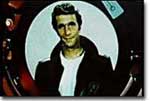
It didn't start airing until 1974, but the television show Happy Daysportrayed the carefree '50s through the antics of characters named Potsie, Chachi, and Fonzie (above).
Gonna cruise her round the town,
Show everybody what I've found
Rock-'n'-roll with all my friends
Hopin' the music never ends.
These happy days are yours and mine.
-Happy Days, theme song
In American memory, the postwar 1950s have acquired an idyllic luster. Reruns of 1950s TV shows such as LEAVE IT TO BEAVER and FATHER KNOWS BEST leave today's viewers with an impression of unadulterated family bliss. The baby boomers look back nostalgically to these years that marked their early childhood experiences.
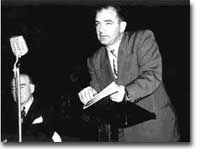
The actions of Senator Joseph McCarthy tarnished the relaxed attitude of the 1950s. His hunt for communists working in the U.S. showcased the paranoia and fear that gripped America.
The president for many of these years was war hero DWIGHT EISENHOWER. Ike, as he was nicknamed, walked a middle road between the two major parties. This strategy, called MODERN REPUBLICANISM, simultaneously restrained Democrats from expanding the New Deal while stopping conservative Republicans from reversing popular programs such as Social Security. As a result, no major reform initiatives emerged from a decade many would describe as politically dead. Perhaps freedom from controversy was the prize most American voters were seeking after World War II and the Korean War.
Living in a Material World
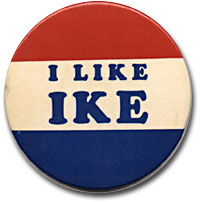
Dwight D. "Ike" Eisenhower's campaign slogan "I Like Ike" epitomized the swell spirit that defined American culture in the 1950s.
A booming economy helped shape the blissful retrospective view of the 1950s. A rebuilding Europe was hungry for American goods, fueling the consumer-oriented sector of the American economy. Conveniences that had been toys for the upper classes such as fancy refrigerators, range-top ovens, convertible automobiles, and televisions became middle-class staples.
The pent-up demand for consumer goods unleashed after the Great Depression and World War II sustained itself through the 1950s. Homes became affordable to many apartment dwellers for the first time. Consequently, the population of the SUBURBS exploded. The huge youth market had a music all of its own called rock and roll, complete with parent-detested icons such as Elvis Presley.
Happy Days — But Not for All
Of course, not everything was as rosy as it seemed. Beneath the pristine exterior, a small group of critics and nonconformists pointed out the flaws in a suburbia they believed had no soul, a government they believed was growing dangerously powerful, and a lifestyle they believed was fundamentally repressed. And much of America was still segregated.
Nevertheless, the notion of the 1950s as happy days lived on. Perhaps when measured against the Great Depression of the 1930s, the world war of the 1940s, the strife of the 1960s, and the malaise of the 1970s, the 1950s were indeed fabulous.
McCarthyism
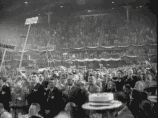
"Our job as Americans and as Republicans is to dislodge the traitors from every place where they've been sent to do their traitorous work." -Joseph McCarthy, speech before the Republican National Convention (1952)
"Are you now, or have you ever been, a member of the Communist party?"
In the 1950s, thousands of Americans who toiled in the government, served in the army, worked in the movie industry, or came from various walks of life had to answer that question before a congressional panel.
SENATOR JOSEPH MCCARTHY rose to national prominence by initiating a probe to ferret out communists holding prominent positions. During his investigations, safeguards promised by the Constitution were trampled.
Why were so many held in thrall to the Wisconsin lawmaker? Why was an environment that some likened to the SALEM WITCH TRIALS tolerated?
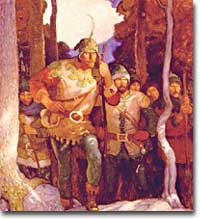
Fears that children would be corrupted by the "communist" practices depicted in Robin Hood led many schools and libraries to ban the classic tale about taking from the rich to give to the poor.
The Atomic Era
In 1947, President Truman had ordered background checks of every civilian in service to the government. When Alger Hiss, a high-ranking State Department official was convicted on espionage charges, fear of communists intensified.
McCarthy capitalized on national paranoia by proclaiming that COMMUNIST SPIES were omnipresent and that he was America's only salvation.
An atmosphere of fear of world domination by communists hung over America in the postwar years. There were fears of a nuclear holocaust based on the knowledge that the Soviet Union exploded its first A-bomb in 1949. That same year, China, the world's most populous nation, became communist. Half of Europe was under Joseph Stalin's influence, and every time Americans read their newspapers there seemed to be a new atomic threat.
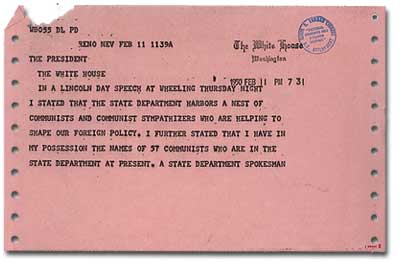
Senator Joseph McCarthy sent this telegram to President Truman two days after claiming that he had identified "205 card-carrying" members of the Communist party working in the U.S. State Department.
At a speech in WHEELING, WEST VIRGINIA, on February 9, 1950, McCarthy launched his first salvo. He proclaimed that he was aware of 205 card-carrying members of the Communist Party who worked for the United States Department of State. A few days later, he repeated the charges at a speech in Salt Lake City. McCarthy soon began to attract headlines, and the Senate asked him to make his case.
McCarthy's Wheeling Speech
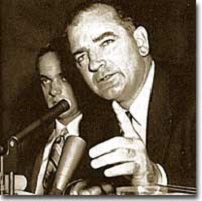
Senator Joe McCarthy and chief counsel Roy Cohn interrogating suspected communists.
At a speech in Wheeling, West Virginia, on February 9, 1950, McCarthy proclaimed that he was aware of 205 card-carrying members of the Communist Party who worked for the United States Department of State. This speech set off an era of paranoia and accusation and propelled McCarthy into the national spotlight.
Ladies and gentlemen, tonight as we celebrate the one hundred and forty-first birthday of one of the greatest men in American history, I would like to be able to talk about what a glorious day today is in the history of the world. As we celebrate the birth of this man who with his whole heart and soul hated war, I would like to be able to speak of peace in our time, of war being outlawed, and of worldwide disarmament. These would be truly appropriate things to be able to mention as we celebrate the birthday of Abraham Lincoln ....
Five years after a world war has been won, men's hearts should anticipate a long peace, and men's minds should be free from the heavy weight that comes with war. But this is not such a period--for this is not a period of peace. This is a time of the "Cold War." This is a time when all the world is split into two vast, increasingly hostile armed camps--a time of great armaments race ...
Six years ago, at the time of the first conference to map out the peace — Dumbarton Oaks — there was within the Soviet orbit 180,000,000 people. Lined up on the antitotalitarian side there were in the world at that time roughly 1,625,000,000 people. Today, only 6 years later, there are 800,000,000 people under the absolute domination of Soviet Russia--an increase of over 400 percent. On our side, the figure has shrunk to around 500,000,000. In other words, in less than 6 years the odds have changed from 9 to 1 in our favor to 8 to 5 against us. This indicates the swiftness of the tempo of Communist victories and American defeats in the cold war. As one of our outstanding historical figures once said, "When a great democracy is destroyed, it will not be because of enemies from without, but rather because of enemies from within."
The truth of this statement is becoming terrifyingly clear as we see this country each day losing on every front.
At war's end, we were physically the strongest nation on earth and, at least potentially, the most powerful intellectually and morally. Ours could have been the honor of being a beacon on the desert of destruction, a shining living proof that civilization was not yet ready to destroy itself. Unfortunately, we have failed miserably and tragically to arise to the opportunity.
The reason why we find ourselves in a position of impotency is not because our only powerful potential enemy has sent men to invade our shores, but rather because of the traitorous actions of those who have been treated so well by this Nation. It has not been the less fortunate or members of minority groups who have been selling this Nation out, but rather those who have had all the benefits that the wealthiest nation on earth has had to offer--the finest homes, the finest college education, and the finest jobs in Government we can give.
This is glaringly true in the State Department. There the bright young men who are born with silver spoons in their mouths are the ones who have been the worst ...
Now I know it is very easy for anyone to condemn a particular bureau or department in general terms. Therefore, I would like to cite one rather unusual case--the case of a man who has done much to shape our foreign policy.
When Chiang Kai-shek was fighting our war, the State Department had in China a young man named John S. Service. His task, obviously, was not to work for the communization of China. Strangely, however, he sent official reports back to the State Department urging that we torpedo our ally Chiang Kai-shek and stating, in effect, that communism was the best hope of China.
Later, this man — John Service — was picked up by the Federal Bureau of Investigation for turning over to the communists Secret state Department information. Strangely, however, he was never prosecuted. However, Joseph Grew, the Undersecretary of State, who insisted on his prosecution, was forced to resign. Two days after Grew's successor, Dean Acheson, took over as Undersecretary of State, this man — John Service — who had been picked up by the FBI and who had previously urged that communism was the best hope of China, was not only reinstated in the State Department but promoted. And finally, under Acheson, placed in charge of all placements and promotions.
Today, ladies and gentlemen, this man Service is on his way to represent the State Department and Acheson in Calcutta — by far and away the most important listening post in the Far East ...
Then there was a Mrs. Mary Jane Kenny, from the Board of Economic Warfare in the State Department, who was named in an FBI report and in a House committee report as a courier for the Communist Party while working for the Government. And where do you think Mrs. Kenny is — she is now an editor in the United Nations Document Bureau ...
This, ladies and gentlemen, gives you somewhat of a picture of the type of individuals who have been helping to shape our foreign policy. In my opinion the State Department, which is one of the most important government departments, is thoroughly infested with Communists.
I have in my hand 57 cases of individuals who would appear to be either card carrying members or certainly loyal to the Communist Party, but who nevertheless are still helping to shape our foreign policy ...
This brings us down to the case of one Alger Hiss who is more important not as an individual any more, but rather because he is so representative of a group in the State Department ...
If time permitted, it might be well to go into detail about the fact that Hiss was Roosevelt's chief advisor at Yalta when Roosevelt was admittedly in ill health and tired physically and mentally ...
According to the then Secretary of State Stettinius, here are some of the things that Hiss helped to decide at Yalta. (1) The establishment of a European High Commission; (2) the treatment of Germany — this you will recall was the conference at which it was decided that we would occupy Berlin with Russia occupying an area completely circling the city, which, as you know, resulted in the Berlin airlift which cost 31 American lives; (3) the Polish question; ... (6) Iran; (7) China — here's where we gave away Manchuria; (8) Turkish Straits question; (9) international trusteeships; (10) Korea....
I know that you are saying to yourself, "Well, why doesn't the Congress do something about it?" Actually, ladies and gentlemen, one of the important reasons for the graft, the corruption, the dishonesty, the disloyalty, the treason in high Government positions--one of the most important reasons why this continues is a lack of moral uprising on the part of the 140,000,000 American people. In the light of history, however, this is not hard to explain.
It is the result of an emotional hang-over and a temporary moral lapse which follows every war. It is the apathy of evil which people who have been subjected to the tremendous evils of war feel. As the people of the world see mass murder, the destruction of defenseless and innocent people, and all of the crime and lack of morals which go with war, they become numb and apathetic. It has always been thus after war.
However, the morals of our people have not been destroyed. They still exist. This cloak of numbness and apathy has only needed a spark to rekindle them. Happily, this spark has finally been supplied.
As you know, very recently the Secretary of State proclaimed his loyalty to a man [Hiss] guilty of what has always been considered as the most abominable of all crime — of being a traitor to the people who gave him a position of great trust. The Secretary of State in attempting to justify his continued devotion to the man who sold out the Christian world to the atheistic world, referred to Christ's Sermon on the Mount as a justification and reason therefore, and the reaction of the American people to this would have made the heart of Abraham Lincoln happy.
When this pompous diplomat in striped pants, with a phony British accent, proclaimed to the American people that Christ on the Mount endorsed communism, high treason, and betrayal of a sacred trust, the blasphemy was so great that it awakened the dormant indignation of the American people.
He has lighted the spark which is resulting in a moral uprising and will end only when the whole sorry mess of twisted, warped thinkers are swept from the national scene so that we may have a new birth of national honesty and decency in government.
On February 20, 1950, McCarthy addressed the Senate and made a list of dubious claims against suspected communists. He cited 81 cases that day. He skipped several numbers, and for some cases repeated the same flimsy information. He proved nothing, but the Senate called for a full investigation. McCarthy was in the national spotlight.
Staying in the headlines was a full-time job. After accusing low-level officials, McCarthy went for the big guns, even questioning the loyalty of DEAN ACHESONand George Marshall. Some Republicans in the Senate were aghast and disavowed McCarthy.
Others such as ROBERT TAFT and Richard Nixon, saw him as an asset. The public rewarded the witch-hunters by sending red-baiters (communist accusers) before the Senate and the House in 1950.
"Tail Gunner Joe" Shot Down
When Dwight Eisenhower became president, he had no love for McCarthy. Ike was reluctant to condemn McCarthy for fear of splitting the Republican Party. McCarthy's accusations went on into 1954, when the Wisconsin senator focused on the United States Army. For eight weeks, in televised hearings, McCarthy interrogated army officials, including many decorated war heroes.
But this was his tragic mistake. Television illustrated the mean-spiritedness of McCarthy's campaign. The army then went on the attack, questioning McCarthy's methods and credibility. In one memorable fusillade, the Council for the Army simply asked McCarthy, "At long last, have you no sense of decency left?"
Poll after poll showed the American people thought McCarthy unscrupulous in his attack of the army.
Fed up, McCarthy's colleagues censured him for dishonoring the Senate, and the hearings came to a close. Plagued with poor health and alcoholism, McCarthy himself died three years later.
Blacklisting
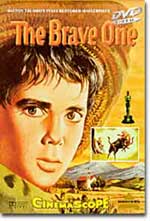
After being blacklisted, Dalton Trumbo, screenwriter and member of the Hollywood Ten, was forced to use false names to continue writing. In 1956, he won an Oscar for The Brave One under the name Robert Rich. It wasn't until 1960 that he could use his real name in Hollywood again.
McCarthy was not the only individual to seek out potential communists.
The HOUSE COMMITTEE ON UN-AMERICAN ACTIVITIES (HUAC) targeted the Hollywood film industry. Actors, writers, and producers alike were summoned to appear before the committee and provide names of colleagues who may have been members of the Communist Party.
Those who repented and named names of suspected communists were allowed to return to business as usual. Those who refused to address the committee were cited for contempt. Uncooperative artists were blacklisted from jobs in the entertainment industry. Years passed until many had their reputations restored.
|
Sir, I detest, I abhor their [communists'] philosophy, but I detest more than that their tactics, which are those of the fifth column, and are dishonest, but at the same time I never as a citizen want to see our country become urged, by either fear or resentment of this group, that we ever compromise with any of our democratic principles through that fear or resentment. I still think that democracy can do it. – Ronald Reagan, testifying in front of the HUAC as president of the Screen Actors Guild (1947) |
||
Were there in fact communists in America?
The answer is undoubtedly yes. But many of the accused had attended party rallies 15 or more years before the hearings — it had been fashionable to do so in the 1930s.
Although the Soviet spy ring did penetrate the highest levels of the American government, the vast majority of the accused were innocent victims. All across America, state legislatures and school boards mimicked McCarthy and HUAC. Thousands of people lost their jobs and had their reputations tarnished.
Other Witch-Hunt Victims
Unions were special target of communist hunters. Sensing an unfavorable environment, the AFL (AMERICAN FEDERATION OF LABOR) and the CIO (CONGRESS OF INDUSTRIAL ORGANIZATIONS) merged in 1955 to close ranks. Books were pulled from library shelves, including Robin Hood, which was deemed communist-like for suggesting stealing from the rich to give to the poor.
No politician could consider opening trade with China or withdrawing from Southeast Asia without being branded a communist. Although McCarthyism was dead by the mid-1950s, its effects lasted for decades.
Above all, several messages became crystal clear to the average American: Don't criticize the United States. Don't be different. Just conform.
Suburban Growth

Convenience and color were two hallmarks of the 1950s kitchen. Pink refrigerators and new pre-sweetened cereals such as Sugar Pops were introduced to America early in the decade.
For many generations and many decades, the AMERICAN DREAM has promised an EGALITARIAN society and material prosperity. For many, the notion of prosperity remained just a dream.
But for millions of Americans in the 1950s, the American Dream became a reality. Within their reach was the chance to have a house on their own land, a car, a dog, and 2.3 kids.
POSTWAR AFFLUENCE redefined the American Dream. Gone was the poverty borne of the Great Depression, and the years of wartime sacrifice were over.

William Levitt offered five different versions of each type of home, but all had the same floor plan.
Automobiles once again rolled off the assembly lines of the Big Three: Ford, General Motors, and Chrysler. The Interstate Highway Act authorized the construction of thousands of miles of high-speed roads that made living farther from work a possibility.
Families that had delayed having additional children for years no longer waited, and the nation enjoyed a postwarBABY BOOM.
Suburbia
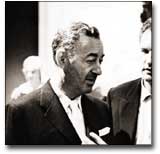
William Levitt revolutionized the way Americans live and ushered in an age of suburbia by providing inexpensive housing outside the city.
Racial fears, affordable housing, and the desire to leave decaying cities were all factors that prompted many white Americans to flee to SUBURBIA. And no individual promoted suburban growth more than WILLIAM LEVITT.
Contracted by the federal government during the war to quickly build housing for military personnel, Levitt applied the techniques of mass production to construction. In 1947, he set out to erect the largest planned-living community in the United States on farmland he had purchased on Long Island, New York. Levitt identified 27 different steps to build a house. Therefore, 27 different teams of builders were hired to construct the homes.
Each house had two bedrooms, one bathroom, and no basement. The kitchen was situated near the back of the house so mothers could keep an eye on their children in the backyard. Within one year, Levitt was building 36 houses per day. His assembly-line approach made the houses extremely affordable. At first, the homes were available only to veterans. Eventually, though,LEVITTOWN was open to others as well.
Keeping Up with the Joneses
With the ability to own a detached home, thousands of Americans soon surpassed the standard of living enjoyed by their parents. Nevertheless, the movement was not without its critics. Architects called Levitt's designs and emphasis on conformity an abomination.
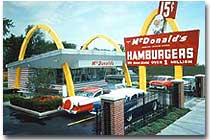
As suburbia grew, fast food restaurants began to pop up all over the country. Ray Kroc bought a single burger joint called McDonald's and paved the way for the fast food giant. Pictured above is Kroc's first new restaurant, which opened in 1955.
Because little variety was expressed in the construction, homeowners struggled to keep their communities looking uniform. Residents had to pledge to mow their lawns on a weekly basis. African Americans were excluded by practice. The irrational need to "keep up with the Joneses" was born in the American suburb.
Despite such criticism, a generation of Americans loved the chance to avoid rent and the dirtiness of the city to live in their own homes on their own land. Soon, shopping centers and fast food restaurants added to the convenience of suburban life. Thousands and thousands migrated to suburbia.
America and the American Dream would never be the same.
Land of Television
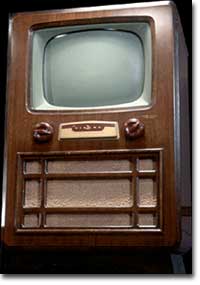
As the price of television sets dropped, the number of viewers grew. 1952 saw the arrival of the Viking Console, a Canadian set, which was popular all over North America.
Perhaps no phenomenon shaped American life in the 1950s more than TELEVISION. At the end of World War II, the television was a toy for only a few thousand wealthy Americans. Just 10 years later, nearly two-thirds of American households had a television.
The biggest-selling periodical of the decade was TV GUIDE. In a nation once marked by strong regional differences, network television programming blurred these distinctions and helped forge a national popular culture.
Television forever changed changed politics. The first president to be televised was Harry Truman. When Estes Kefauver prosecuted mob boss Frank Costello on television, the Tennessee senator became a national hero and a vice presidential candidate.
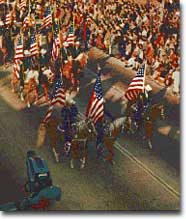
The first coast-to-coast color broadcast came on January 1, 1954, when NBC beamed the Tournament of Roses Parade across America.
It did not take long for political advertisers to understand the power of the new medium. Dwight Eisenhower's campaign staff generated sound bites — short, powerful statements from a candidate — rather than air an entire speech.
America Loves Lucy
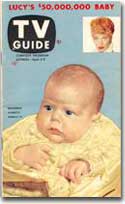
Lucille Ball's new baby brought 44 million viewers to the show and graced the cover of the first national issue of TV Guide in 1953. TV Guide soon became the most popular periodical in the country.
Americans loved situation comedies — sitcoms. In the 1950s, I LOVE LUCYtopped the ratings charts. The show broke new ground by including a Cuban American character (Ricky Ricardo, played by bandleader DESI ARNAZ) and dealing with LUCILLE BALL's pregnancy, though Lucy was never filmed from the waist down while she was pregnant. Forty-four million Americans tuned in to welcome her newborn son to the show.
Through shows such as Leave It to Beaver, THE DONNA REED SHOW, and Father Knows Best, television created an idyllic view of what the perfect family life should look like, though few actual families could live up to the ideal.
Television's idea of a perfect family was a briefcase-toting professional father who left daily for work, and a pearls-wearing, nurturing housewife who raised their mischievous boys and obedient girls.
With rare exceptions (such as Desi Arnaz) members of minorities rarely appeared on television in the 1950s.
The Wild West
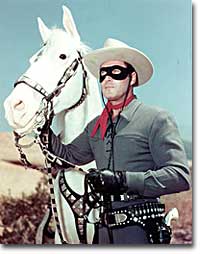
The Lone Ranger was one of the earliest TV Westerns, making the jump from radio in 1941. The Lone Ranger and other Westerns geared toward children aired on Saturday mornings. Adult Westerns, such asGunsmoke and Wyatt Earp aired during prime-time.
America's fascination with the Wild West was nothing new, but television brought Western heroes into American homes and turned that fascination into a love affair. Cowboys and lawmen such as HOPALONG CASSIDY, WYATT EARP, and the CISCO KIDgalloped across televisions every night.
THE ROY ROGERS SHOW and RIN TIN TINbrought the West to children on Saturday mornings, and DAVY CROCKETT coonskin caps became popular fashion items. Long running horse operas, such as BONANZAand RAWHIDE, attracted viewers week after week.
One Western, GUNSMOKE, ran for 20 years — longer than any other prime-time drama in television history. At the decade's close, 30 Westerns aired on prime time each week, and Westerns occupied 7 spots in the Nielsen Top-10.
Westerns reinforced the '50s notion that everything was OK in America. LikeTHE LONE RANGER or ZORRO, most programs of the early 1950s drew a clear line between the good guys and the bad guys. There was very little danger of injury or death, and good always triumphed in the end.
By the late '50s, though, the genre had become more complicated and the lines between good and evil was blurred. America entered the more turbulent '60s with heroes such as the black-clad mercenary Paladin and the gambling Maverick brothers who would do anything to earn a buck.
Nixon and Checkers
Richard Nixon was both helped and hindered by TV. His televisedCHECKERS SPEECH (Checkers was his dog) successfully appealed to the public for support when financial scandals threatened to boot him from the Republican ticket. But in the 1960 televised presidential debates against John F. Kennedy, Nixon came off as sweaty and somewhat sinister.
Variety Shows: Vaudeville in American Living Rooms
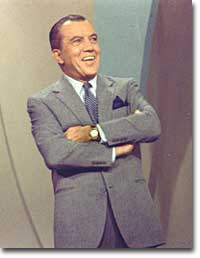
Ed Sullivan's variety show provided entertainment ranging from the rock and roll of the Rolling Stones to the goofy hijinks of trained animals.
Because most early television was live, the producers of major networks found their talent among people already had experience with live performance: vaudeville. Television and vaudeville combined to created the form of entertainment known as the variety show.VARIETY SHOWS were made up of short acts — musical numbers, comedy sketches, animal tricks, etc. — usually centered around an engaging host. Former vaudevillians BOB HOPE, MILTON BERLE, and Ed Wynn all hosted popular programs. The influence of vaudeville on television was so strong that television critics called the shows "Vaudeo."
Sid Caesar had two popular variety programs in '50s, Your Show of Showsand Caesar's Hour. These shows featured the writing talents of CARL REINER,MEL BROOKS, LARRY GELBART, and WOODY ALLEN. NAT "KING" COLE became the first African American host of a television series when his variety show appeared in 1956.
But perhaps no variety program had a greater effect on American culture thanTHE ED SULLIVAN SHOW, which ran for 23 years beginning in 1948 and was for a while America's most popular show. Combining highbrow and popular entertainment, Sullivan's "really big shew" became a major stop for both established performers and young, up-and-coming artists. Although Elvis Presley had appeared on other shows in the past, it was his performance onThe Ed Sullivan Show that grabbed the headlines. By securing rock-and-roll acts, Sullivan won the adolescent market, truly making the variety show a whole-family event.
Commercials: Selling through the Screen
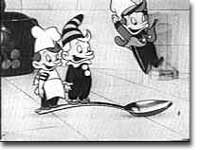
In 1955, the adorable cartoon characters Snap, Crackle, and Pop leapt around and sang about the joys of eating Rice Krispies. Advertisements were an integral part of television viewing then just as they are today.
With more and more American families owning televisions, manufacturers now had a new way to sell their products, and the TELEVISION COMMERCIAL was born. By late 1948, over 900 companies had bought television broadcast time for advertising. By 1950, sponsors were leaving radio for television at an unstoppable rate.
Television sponsors ranged from greeting cards to automobiles, but perhaps the most advertised product was tobacco. TV Guide voted Lucky Strike's "Be Happy, Go Lucky" ad commercial of the year for 1950, and Phillip Morris sponsored I Love Lucy for years, inserting cartoon cigarette packs in the show's opening animation. Cartoon characters were common in '50s commercials, representing everything from lightbulbs to beer. In 1950, Coca-Cola launched its first television ad campaign using a combination of animation and celebrity endorsement.
By 1954, television commercials were the leading advertising medium in America. The life of the American consumer would never be the same.
The New News
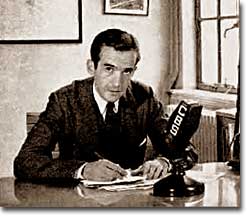
Most Americans still got their news from newspapers in the 1950s, but the foundations for the modern television newscast were established as early as 1951 withEDWARD R. MURROW's SEE IT NOW, the first coast-to-coast live show. Many consider Murrow's 1953PERSON TO PERSON interview with Joseph McCarthy to be a major step toward McCarthy's downfall.
While Murrow reported on CBS,DAVID BRINKLEY and CHET HUNTLEYwere revolutionizing news broadcasting with the NBC Nightly News. Brinkley and Huntley were the first anchormen to report from two cities simultaneously, and Brinkley's simple declarative sentences became the basis for television news writing for several decades.
Two major developments in the 1950s that set up television as the news medium of the future were the establishment of coaxial cable linking the East and West coasts, which enabled footage to be moved electronically instead of physically, and the invention of videotape, which allowed the use of prerecorded footage (such as studio interviews).
|
But when television is bad, nothing is worse. I invite you to sit down in front of your television set when your station goes on the air and stay there without a book, magazine, newspaper, profit-and-loss sheet or rating book to distract you — and keep your eyes glued to that set until the station signs off. I can assure you that you will observe a vast wasteland. You will see a procession of game shows, violence, audience participation shows, formula comedies about totally unbelievable families, blood and thunder, mayhem, violence, sadism, murder, western bad men, western good men, private eyes, gangsters, more violence and cartoons. And, endlessly, commercials — many screaming, cajoling and offending. And most of all, boredom. – Newton Minow, Chairman of the FCC and 1950s televison viewer (1961) |
||
Children's Programming
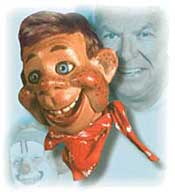
The Howdy Doody Show, the first children's program to run five days a week, helped the young NBC network grow exponentially during the 1950s.
America Rocks and Rolls
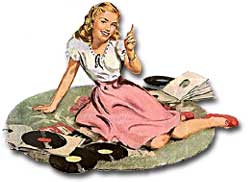
The prosperity of the '50s allowed teenagers to spend money on records by their favorite bands and singers.
ROCK AND ROLL was everything the suburban 1950s were not. While parents of the decade were listening to FRANK SINATRA, PERRY COMO, and BIG BANDS, their children were moving to a new beat.
In fact, to the horror of the older generation, their children were twisting, thrusting, bumping, and grinding to the sounds of rock and roll.
This generation of youth was much larger than any in recent memory, and the prosperity of the era gave them money to spend on records and phonographs. By the end of the decade, the phenomenon of rock and roll helped define the difference between youth and adulthood.
The Roots of Rock
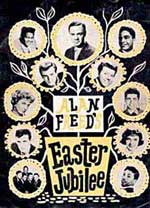
Alan Freed, the Cleveland disc jockey credited with coining the phrase "rock and roll," was the master of ceremonies at many of the first rock concerts, including his 1955 Easter Jubilee.
The roots of rock and roll lay in African AmericanBLUES and GOSPEL. As the Great Migration brought many African Americans to the cities of the north, the sounds of RHYTHM AND BLUES attracted suburban teens. Due to segregation and racist attitudes, however, none of the greatest artists of the genre could get much airplay.
Disc jockey Alan Freed began a rhythm-and-blues show on a Cleveland radio station. Soon the audience grew and grew, and Freed coined the term "rock and roll."
Early attempts by white artists to cover R&B songs resulted in weaker renditions that bled the heart and soul out of the originals. Record producers saw the market potential and began to search for a white artist who could capture the African American sound.
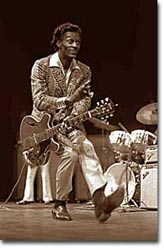
Chuck Berry's songs about girls and cars hit a nerve with American teens and sent his star rising high in the early days of rock and roll.
SAM PHILLIPS, a Memphis record producer, found the answer in Elvis Presley. With a deep Southern sound, pouty lips, and gyrating hips, Elvis took an old style and made it his own.
From Memphis, the sound spread to other cities, and demand for Elvis records skyrocketed. Within two years, Elvis was the most popular name in the entertainment business.
After the door to rock and roll acceptance was opened, African American performers such as Chuck Berry, FATS DOMINO, and LITTLE RICHARDbegan to enjoy broad success, as well. White performers such as Buddy Holly and Jerry Lee Lewis also found artistic freedom and commercial success.
Satan's Music
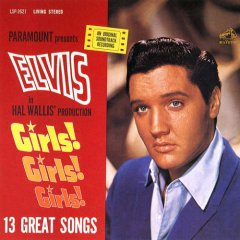
Elvis Presley brought rock-and-roll music to the masses during the 1950s with hits such as "Love Me Tender" and "Heartbreak Hotel."
Rock and roll sent shockwaves across America. A generation of young teenagers collectively rebelled against the music their parents loved. In general, the older generation loathed rock and roll. Appalled by the new styles of dance the movement evoked, churches proclaimed it Satan's music.
Because rock and roll originated among the lower classes and a segregated ethnic group, many middle-class whites thought it was tasteless. Rock and roll records were banned from many radio stations and hundreds of schools.
But the masses spoke louder. When Elvis appeared on TV's The Ed Sullivan Show, the show's ratings soared.
|
Rock and roll is the most brutal, ugly, degenerate, vicious form of expression — lewd, sly, in plain fact, dirty — a rancid-smelling aphrodisiac and the martial music of every side-burned delinquent on the face of the earth. – Frank Sinatra (1957) |
||
The commercial possibilities were limitless. As a generation of young adults finished military service, bought houses in suburbia, and longed for stability and conformity, their children seemed to take comfort for granted. They wanted to release the tensions that bubbled beneath the smooth surface of postwar America.
Above all, they wanted to shake, rattle, and roll.
The Cold War Continues
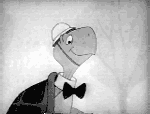
Cartoons of the unflappable Bert the Turtle warned American children everywhere during the Cold War to "duck and cover" in the event of a nuclear blast. Although these measures would have proved useless, schools vigorously pursued "duck and cover" drills in which children clambered beneath their desks.
The end of the Korean War in 1953 by no means brought an end to global hostilities.
As the British and French Empires slowly yielded to independence movements, a new Third World emerged. This became the major battleground of the Cold War as the United States and the Soviet Union struggled to bring new nations into their respective orbits. Across the Third World, the two superpowers squared off through proxy armies.
The United States's recognition of Israel in 1948 created a strong new ally, but created many enemies. Arab nations, enraged by American support for the new Jewish state, found supportive ears in the Soviet Union.
When Egyptian President GAMAL ABDEL NASSERsought to strengthen ties with the Soviet bloc, the United States withdrew its pledge to help Nasser construct the all-important ASWAN DAM. Nasser responded by nationalizing the SUEZ CANAL, an action that compelled British, French, and Israeli armies to invade Egypt.

Egyptian president Gamal Abder Nasser's 1956 nationalization of the Suez Canal, crippled the ability of Great Britain and France to trade internationally. As a result, the two countries allied with Israel to attack Egypt.
The Eisenhower Doctrine
The Western alliance was threatened as President Dwight Eisenhower called upon Britain and France to show restraint. With Soviet influence growing in the oil-rich region, Ike issued the Eisenhower Doctrine, which pledged American support to any governments fighting communist insurgencies in the Middle East. Making good on that promise, he sent over 5,000 marines toLEBANON to forestall an anti-Western takeover.
Asia provided more challenges for American containment policy. China was flexing its muscles on TAIWAN by threatening the takeover of the Taiwanese islands of QUEMOY AND MATSU. United States Secretary of State JOHN FOSTER DULLES chose to follow a strategy of brinkmanship. He told China that any aggressive actions toward the islands would be met by force from the United States.
In a grown-up version of the children's game of chicken, Dulles hoped to avoid war by threatening war. The Chinese shelled the islands to save face, but no takeover occurred.
To the south, communist revolutionary Ho Chi Minh successfully defeated the French colonial army to create the new nation of Vietnam. American commitment to the containment of communism led to a protracted involvement that would become the Vietnam War.
Ethel and Julius Rosenberg Sentencing Excerpts
One 1950s Cold War catalyst of fear was the capture and conviction ofETHEL AND JULIUS ROSENBERG for selling nuclear secrets to the Soviet Union. Although the FBI advised sparing Ethel Rosenberg's life (she had two children), JUDGE IRVING KAUFMAN refused to do so and sentenced her to death with her husband. The trial and sentencing were controversial, partly due to charges of anti-Semitism.
Citizens of this country who betray their fellow-countrymen can be under none of the delusions about the benignity of Soviet power that they might have been prior to World War II. The nature of Russian terrorism is now self-evident.
I consider your crime worse than murder. Plain, deliberate, contemplated murder is dwarfed in magnitude by comparison with the crime you have committed. In committing the act of murder, the criminal kills only his victim. The immediate family is brought to grief, and when justice is meted out the chapter is closed. But in your case, I believe your conduct in putting into the hands of the Russians the A-bomb years before our best scientists predicted Russia would perfect the bomb has already caused, in my opinion, the Communist aggression in Korea, with the resultant casualties exceeding 50,000 and who knows but that millions more of innocent people may pay the price of your treason. Indeed, by your betrayal you undoubtedly have altered the course of history to the disadvantage of our country.
No one can say that we do not live in a constant state of tension. We have evidence of your treachery all around us every day — for the civilian defense activities throughout the nation are aimed at preparing us for an atom bomb attack. Nor can it be said in mitigation of the offense that the power which set the conspiracy in motion and profited from it was not openly hostile to the United States at the time of the conspiracy. If this was your excuse the error of your ways in setting yourselves above our properly constituted authorities and the decision of those authorities not to share the information with Russia must now be obvious ....
In the light of this, I can only conclude that the defendants entered into this most serious conspiracy against their country with full realization of its implications ....
The statute of which the defendants at the bar stand convicted is clear. I have previously stated my view that the verdict of guilty was amply justified by the evidence. In the light of the circumstances, I feel that I must pass such sentence upon the principals in this diabolical conspiracy to destroy a God-fearing nation, which will demonstrate with finality that this nation's security must remain inviolate; that traffic in military secrets, whether promoted by slavish devotion to a foreign ideology or by a desire for monetary gains, must cease.
The evidence indicated quite clearly that Julius Rosenberg was the prime mover in this conspiracy. However, let no mistake be made about the role which his wife, Ethel Rosenberg, played in this conspiracy. Instead of deterring him from pursuing his ignoble cause, she encouraged and assisted the cause. She was a mature woman — almost three years older than her husband and almost seven years older than her younger brother. She was a full-fledged partner in this crime.
Indeed, the defendants, Julius and Ethel Rosenberg, placed their devotion to their cause above their own personal safety and were conscious that they were sacrificing their own children should their misdeeds be detected — all of which did not deter them from pursuing their course. Love for their cause dominated their lives — it was even greater than their love for their children.
– excerpt from Judge Kaufman's sentencing of convicted spies Julius and Ethel Rosenberg, in which he sentenced them to death (April 5, 1951)
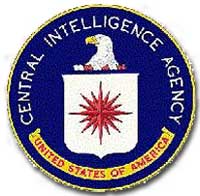
The CIA was formed after World War II to monitor the potential threat of communist countries.
The CIA
In the aftermath of World War II, the United States created a new weapon to assist in fighting the Cold War: theCENTRAL INTELLIGENCE AGENCY. In addition to gathering information on Soviet plans and maneuvers, the CIA also involved itself in covert operations designed to prevent communist dictators from rising to power.
The first such instance occurred in Iran, when Iranian Prime Minister MOHAMMED MOSSADEGH nationalized BRITISH PETROLEUM. Fearing Soviet influence in the powerful oil nation, the CIA recruited a phony mob to drive off Mossadegh and return the American-backed SHAH MOHAMMAD REZA PAHLAVI to power.
When JACOBO ARBENZ came to power in Guatemala, he promised to relieve the nation's impoverished farmers by seizing land held by the American-ownedUNITED FRUIT COMPANY and redistributing it to the peasants. With the support of American air power, a CIA-backed band of mercenaries overthrew Arbenz and established a military dictatorship.

Beginning on July 4, 1956, U-2 spy planes infiltrated Soviet airspace to take photos and determine the number of bomber planes possessed by the USSR. The secret flights lasted until 1960, when a U-2 plane was shot down.
Throughout Latin America, the United States was seen as a brutal defender of thuggish autocrats at the expense of popularly elected leaders. Fidel Castro capitalized on this sentiment by overthrowing U.S.-backed dictator Fulgencio Batista from power in Cuba in January 1959.
Policy of Mass Retaliation
Relations remained icy between the United States and the Soviet Union. Relying on the knowledge that the United States had a much larger nuclear arsenal than the Soviet Union, Eisenhower and Dulles announced a policy of massive retaliation. Any attack by the Soviets on the United States or its allies would be met with nuclear force.
The Soviet crackdown on the HUNGARIAN UPRISING OF 1956 further strained relations. In an effort to reduce tensions, Eisenhower offered an "OPEN SKIES" PROPOSAL to Soviet leader NIKITA KHRUSHCHEV. Planes from each nation would be permitted to fly over the other to inspect nuclear sites. But Khrushchev declined the offer. A summit conference between Eisenhower and Khrushchev was canceled in 1960 when the Soviets shot down an American U-2 SPY PLANEpiloted by GARY POWERS.
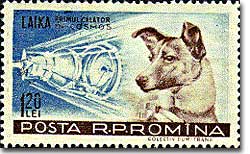
This stamp commemorates Laika, the dog that was sent into space on the second Soviet satellite, Sputnik II, in November 1957. The launch of the first Sputnik earlier that year triggered a massive American effort to catch up to Soviet space technology, culminating in 1969 with the U.S. mission to the Moon.
Despite the passing of Joseph Stalin, Americans continued to view the Soviet Union as the Great Red Menace.
When the USSR put SPUTNIK into orbit in 1957, panic struck the American heartland. Thousands rushed to Sears and Roebuck to purchase bomb shelter kits, and Congress responded by creating the NATIONAL AERONAUTICAL AND SPACE ADMINISTRATION and by appropriating funds for science education.
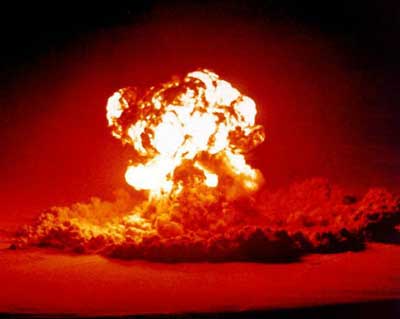
The mushroom cloud above was photographed in a 1956 nuclear test known as Operation Plumbbob. The possibility of nuclear war loomed over terrified Americans in the 1950s.
Not even outer space was safe from Cold War confrontation.
Voices against Conformity
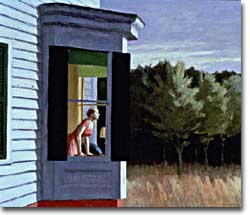
Edward Hopper's Cape Cod Morning (1950) is typical of his lonely, New England scenes depicting a solitary figure. The somber tone of his paintings starkly contrasts with the typical 1950s representations of saccharine, happy-go-lucky American life.
Many in the 1950s strove for the comfort and conformity depicted on such TV shows as Father Knows Best and Leave It to Beaver.
But despite the emerging affluence of the new American middle class, there was a poverty, racism, and alienation in America that was rarely depicted on TV.
Minorities seemed to be shut out from the emerging American Dream.
Poverty rates for African Americans were typically double those of their white counterparts. Segregation in the schools, the lack of a political voice, and longstanding racial prejudices stifled the economic advancement of many African Americans. In 1952, Ralph Ellison penned INVISIBLE MAN, which pinpointed American indifference to the plight of African Americans. "I am an invisible man," he wrote. "I am invisible, understand, simply because people refuse to see me ..."
Latino Americans languished in urban American barrios, and the Eisenhower Administration responded with a program — derisively named Operation Wetback — designed to deport millions of Mexican Americans .
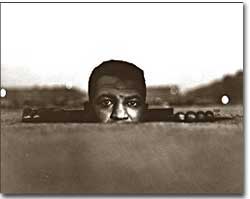
While writing parts of Invisible Man, Ralph Ellison lived at Gordon Parks's home. Parks, a photographer, made a series of prints that were his interpretation of events in Ellison's novel. This one is entitled Man Peeking from Manhole, Harlem (1949).
Reservation poverty increased with the Eisenhower policy of "TERMINATION," designed to end federal support for tribes. Incentives such as relocation assistance and job placement were offered to Native Americans who were willing to venture off the reservations and into the cities. Unfortunately, the government excelled at relocation but struggled with job placement, leading to the creation of Native American ghettos in many western cities.
Ethnic minorities — Jews, Italians, Asians, and many groups — all struggled to find their place in the American quilt.
The Beat Generation
In the artistic world, dozens of beat writers reviled middle-class materialism, racism, and uniformity. Other intellectuals were able to detach themselves enough from the American mainstream to review it critically.
The writers of the BEAT GENERATION refused to submit to the conformity of the 1950s. GREENWICH VILLAGE in New York City was the center of the beat universe. Epitomized by such Columbia University students such JACK KEROUAC and ALLEN GINSBERG, the beats lived a bohemian lifestyle.
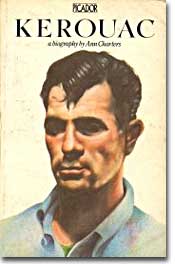
In 1957, Kerouac published On the Road, the definitive Beat Generation novel. The beats were a subculture of young people dissatisfied with the blandness of American culture and its shallow, rampant consumerism.
While mainstream America seemed to ignore African American culture, the beats celebrated it by frequenting jazz clubs and romanticizing their poverty. The use of alcohol and drugs foreshadowed the counterculture of the following decade. Believing that American society was unspeakably repressed, the beats experimented with new sexual lifestyles.
In ON THE ROAD, Kerouac's hero travels around the nation, delving into America's fast-living underside. In "HOWL," Allen Ginsberg assails materialism and conformity and calls for the unleashing of basic human needs and desires.
As the media helped create a single notion of an idyllic American lifestyle, a vocal minority of social critics registered their dissenting voices. The notion of the white-collar, executive-track, male employee was condemned in fiction in SLOAN WILSON's THE MAN IN THE GRAY FLANNEL SUIT and in commentary in WILLIAM WHYTE's THE ORGANIZATION MAN.
The booming postwar defense industry came under fire in C. WRIGHT MILLS'THE POWER ELITE. Mills feared that an alliance between military leaders and munitions manufacturers held an unhealthy proportion of power that could ultimately endanger American democracy — a sentiment echoed in PRESIDENT EISENHOWER'S FAREWELL ADDRESS.
And teen alienation and the neurosis of coming-of-age in postwar America was examined in J.D. SALINGER's THE CATCHER IN THE RYE.
|
If you really want to hear about it, the first thing you'll probably want to know is where I was born, and what my lousy childhood was like, and how my parents were occupied and all before they had me, and all that David Copperfield kind of crap, but I don't feel like going into it, if you want to know the truth. In the first place, that stuff bores me, and in the second place, my parents would have about two hemorrhages apiece if I told anything pretty personal about them. They're nice and all — I'm not saying that — but they're also touchy as hell. – Holden Caulfield, from The Catcher in the Rye by J.D. Salinger (1951) |
||
Painting against the Tide
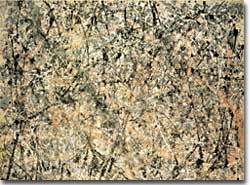
Jackson Pollock's 1950 painting Lavender Misttypifies "Action painting," in which he fixed his canvas to the floor, then dripped paint all over it. Pollock's unorthodox methods were heavily criticized (he was labeled "Jack the Dripper"), but his novel painting style proved that American artists were on par with their European counterparts.
American painters also took shots at conformity. EDWARD HOPPERwho had made a name for himself in earlier decades, combated the blissful images of television by showing an America full of loneliness and alienation.
In New York City, painters broke with the conventions of Western art to create abstract expressionism, widely regarded as the most significant artistic movement ever to come out of America. Abstract expressionists, such as WILLEM DE KOONING, HANS HOFFMAN, MARK ROTHKO, and Jackson Pollock, sought to express their subconscious and their dissatisfaction with postwar life through unique and innovative paintings. The physical act of painting was almost as important as the work itself. JACKSON POLLOCK gained fame through "ACTION PAINTING" — pouring, dripping, and spattering the paint onto the canvas. Rothko covered his canvas with large rectangles, which he believed conveyed "basic human emotions."
Big Screen Rebels
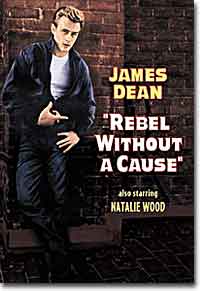
"Rebel without a Cause," a story of anguished middle-class juvenile delinquents, was an instant sensation when released in 1955. The film was particularly scandalous because the main characters "came from good families." James Dean played the main character, Jim Stark.
While the 1950s silver screen lit up mostly with the typical Hollywood fare of Westerns and romances, a handful of films shocked audiences by uncovering the dark side of America's youth. MARLON BRANDOplayed the leather-clad leader of a motorcycle gang that ransacks a small town. In 1953's THE WILD ONE. The film terrified adults but fascinated kids, who emulated Brando's style. 1955 saw the release of BLACKBOARD JUNGLE, a film about juvenile delinquency in an urban high school. It was the first major release to use a rock-and-roll soundtrack and was banned in many areas both for its violent take on high school life and its use of multiracial cast of lead actors.
Perhaps the most controversial and influential of these films is 1955's REBEL WITHOUT A CAUSE. Another film about teenage delinquency (the main characters meet at the police station) Rebel is not set amid urban decay, but rather in an affluent suburb. "And they both come from 'good' families!" the film's tagline screamed. Ironically, the film made it clear that the failure of those very families was to blame for the main characters' troubles. Juvenile delinquency was no longer a problem for the lower classes; it was lurking in the supposedly perfect suburbs. Once again parents were outraged, but the message could no longer be ignored. The film earned three Academy Award nominations and propelled JAMES DEAN to posthumous but eternal stardom.
Sex Education
Puritanical sexual mores were challenged by ALFRED KINSEY's successive reports SEXUAL BEHAVIOR IN THE HUMAN MALE and SEXUAL BEHAVIOR IN THE HUMAN FEMALE. Kinsey revealed a much greater prevalence of premarital sex, extramarital affairs, and homosexuality than mainstream public discourse would have suggested. Americans were somehow surprised to read that, according to Kinsey, women actually enjoyed sexual experiences as much as men.
Despite the clear presence of poverty, alternative literature, and social criticism, Americans on the whole turned away and enjoyed happy days during the 1950s. But happy days values were soon about to make way for the 1960s.
"You say you want a revolution?"
